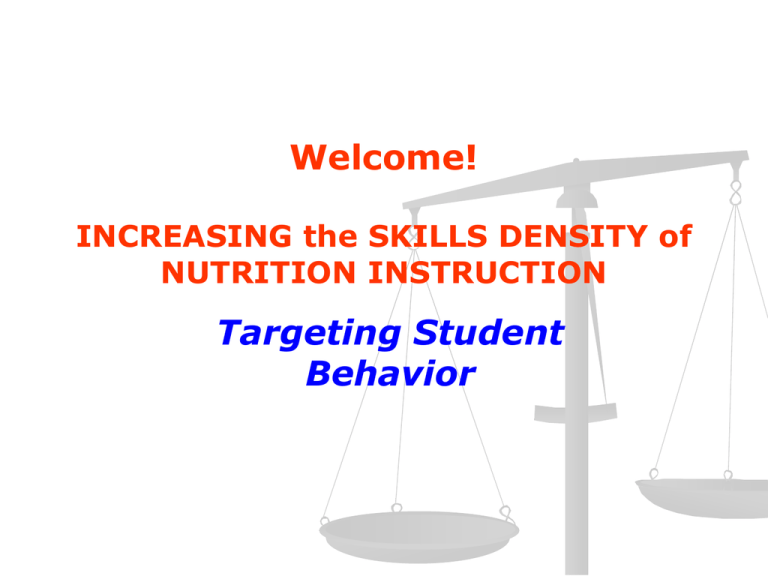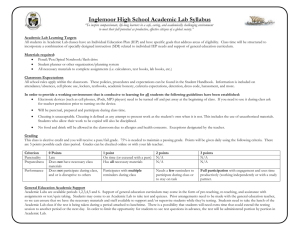Skills Density PowerPoint - California Healthy Kids Resource Center
advertisement

Welcome! INCREASING the SKILLS DENSITY of NUTRITION INSTRUCTION Targeting Student Behavior Skills Density Workshop - Objectives • The California Health Education Content Standards. • Distinguish between low- and high-skills density nutrition activities. • Identify lesson plans with high nutrition skills density. • Access resources with high nutrition skills density instruction. • Reflection. Answer True or False 1. It is healthy to wear a seat belt. 2. It is healthy to eat a nutritious breakfast every day. 3. It is healthy to brush and floss your teeth. 4. It is healthy to get 30 minutes of aerobic exercise at least 3 times a week. 5. It is healthy to get adequate sleep. Quiz 1 Answer True or False 1. I always wear a seat belt. 2. I regularly eat a nutritious breakfast. 3. I brush and floss daily. 4. I get 30 minutes of aerobic exercise at least 3 times a week. 5. I always get adequate sleep. Did your results differ? _________ Quiz 2 Nutrient Density (ND) Continuum Low ND High ND Low Nutritional Value High Nutritional Value Nutrient Density - the amount of nutrients (vitamins and minerals) in a food compared to its calories. Low Density Nutrient Density High Density Capri Sun (16 oz.) Nutrients Orange Juice (16 oz) 220 Calories 220 Total Fat 60 grams Sugars 48 grams Protein 4 grams Potassium 900 mg (26%) Vitamin C 120 mcg (200%) Vitamin A 728 IU (18%) Folate 120 mcg (30%) Calcium 52 mg (4%) Magnesium 54 mg (12%) Thiamin 0.5 mg (20%) Vitamin B-6 0.3 mg (8%) Nutrient Density (ND) Continuum Low ND Low Nutritional Value High ND High Nutritional Value Nutrient Density (ND) Continuum Low ND High ND Insert these terms into the sentence below: nutritional value each of the food groups optimizes student health high Nutrient Density Choosing foods that have _____ from ______increases _______ (outcome 1), and (outcome 2). Getting the Best Investment California Health Education Content Standards Standard 1: All students will comprehend essential concepts related to enhancing health. (Essential Health Concepts) Standard 2: All students will demonstrate the ability to analyze internal and external influences that affect health. (Analyzing Health Influences) Standard 3: All students will demonstrate the ability to access and analyze health information, products, and services. (Accessing Valid Health Information) Standard 4: All students will demonstrate the ability to use interpersonal communication skills to enhance health. (Interpersonal Communication) Standard 5: All students will demonstrate the ability to use decision-making skills to enhance health. (Decision Making) Standard 6: All students will demonstrate the ability to use goal-setting skills to enhance health. (Goal Setting) Standard 7: All students will demonstrate the ability to practice behaviors that reduce risk and promote health. (Practicing Health-Enhancing Behaviors) Standard 8: All students will demonstrate the ability to promote health for personal, family, and community health. (Health Promotion) Musical Shares When the music begins, walk around the room silently. When the music stops, find a partner and share the information that has been chosen to share. When the music starts again, leave your partner and walk around the room. When the music stops, find another partner and share the information that has been chosen to share. Nutrition Skills Density (NSD) Continuum Low NSD Low Instructional Value High NSD High Instructional Value Nutrition Skills Density (NSD) Continuum Low NSD Sample Nutrition Education Activity 1: The instructor reads Everybody Cooks Rice to the class. Students draw pictures of the ingredients used in the rice dishes. Students practice spelling the ingredients. High NSD Nutrition Skills Density (NSD) Continuum Low NSD Sample Nutrition Education Activity 2: The instructor reads Everybody Cooks Rice to the class. Students compare how the rice dishes differ (e.g., ingredients, smell, color, cooking methods, countries of origin). Students write a sentence about how each affects their choices. At home the students log the influences on their afterschool snack choices. High NSD Nutrition Skills Density (NSD) Continuum Low NSD High NSD Set a goal and develop a plan for eating two or more oranges a week Sing about oranges Analyze marketing strategies used in an orange soda commercial Draw an orange, label parts Measure an orange Compare the nutrient density of orange juice and orange drink Learn to and practice peeling an orange Write a letter to the food service director advocating for more oranges Watch a video about oranges California Health Education Content Standards Standard 1: All students will comprehend essential concepts related to enhancing health. (Essential Health Concepts) Standard 2: All students will demonstrate the ability to analyze internal and external influences that affect health. (Analyzing Health Influences) Standard 3: All students will demonstrate the ability to access and analyze health information, products, and services. (Accessing Valid Health Information) Standard 4: All students will demonstrate the ability to use interpersonal communication skills to enhance health. (Interpersonal Communication) Standard 5: All students will demonstrate the ability to use decision-making skills to enhance health. (Decision Making) Standard 6: All students will demonstrate the ability to use goal-setting skills to enhance health. (Goal Setting) Standard 7: All students will demonstrate the ability to practice behaviors that reduce risk and promote health. (Practicing Health-Enhancing Behaviors) Standard 8: All students will demonstrate the ability to promote health for personal, family, and community health. (Health Promotion) Insert these terms into the sentence below: each of the CHECS instructional value high Nutrition Skills Density maximizes student behavioral impact Choosing instructional activities that have _____ __from _____ increases _(outcome 1), and _(outcome 2). Nutrition Skills Density Discover Skill Development in Existing Curricula Activity Check the directions for the activity Decide individually whether the lesson is low or high Skills Density Discuss the lesson with your group Prepare to give a report to the whole group CHKRC Web Site www.californiahealthykids.org California After School Resource Center (CASRC) www.californiaafterschool.org Skills Density Workshop - Objectives • The California Health Education Content Standards. • Distinguish between low- and high-skills density nutrition activities. • Identify lesson plans with high nutrition skills density. • Access resources with high nutrition skills density instruction. • Reflection. INCREASING the SKILLS DENSITY of NUTRITION INSTRUCTION Targeting Student Behavior Contact information: Jacquelyn Russum, MPH, RD Phone – 510-670-4585 or Toll Free – 1-888-318-8188 E-mail – jrussum@californiahealthykids.org This material was funded by USDA’s Food Stamp Program through the Network for a Healthy California. This institution is an equal opportunity provider and employer. The Food Stamp Program provides nutrition assistance to people with low income. It can help buy nutritious foods for a better diet. For information on the Food Stamp Program, call 1-888-328-3483.






